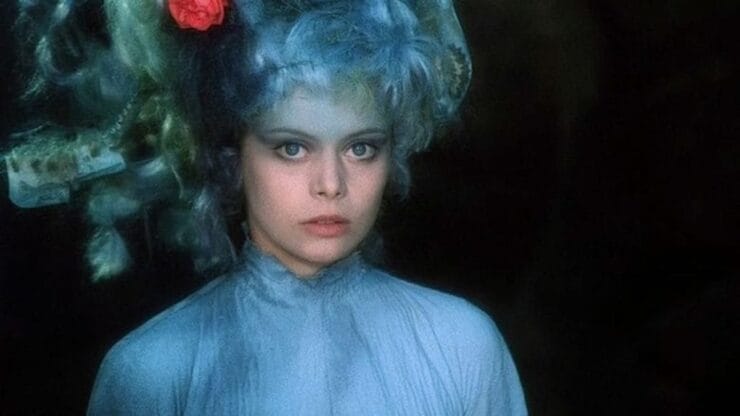Thanks to commenter aethelred for pointing me toward Karel Kachyna’s 1976 Czech-language version of The Little Mermaid. It’s available on Youtube with carefully curated English subtitles, and it is a trip.
It’s not quite as close to the Andersen original as I expected, but it hits within a fathom or two of most of the main points. The King of the Sea has six daughters, all of whom have names, unlike in the original—except the youngest, who remains The Little Mermaid. Each one is allowed to journey to the surface on her birthday. The youngest is fascinated by humans and studies them as intensively as she can. She longs to know their world, and on her birthday, not only does she see the surface; she rescues a prince from a shipwreck, and leaves him on the shore. For a year after, she comes up again and again, though she never sees him; she watches the seasons change, and sees the creatures of the land, from birds to horses.
There’s the sea witch, of course, with her lair guarded by dangerous creatures, and the bargain she strikes is familiar: she takes the Mermaid’s beautiful voice in return for giving her the semblance of a human. The ending is tragic, with the prince mistaking the girl who found him for the one who saved him, marrying her, and condemning his true savior to melt into sea-foam. Her father offers her a way out, sends her a knife to kill the prince and take his heart’s blood, but she can’t bear to do it. She chooses death instead.
Here as in the rest of the filmed versions, there’s no mention of a soul. When she dies, she dies, though in this film she transforms into a carpet of flowers that calms the sea and saves the now wedded prince from another shipwreck. She becomes human for love of the prince; that’s the whole reason for her sacrifice. The metaphysical and theological element is gone. It’s all about the physical.
Kachyna’s realization of the story owes next to nothing to special effects. What few there are are strictly minimal. There’s an ongoing loop of stormy sea, a tall ship under full sail, and some fairly alarming pyrotechnics on the way to the Sea Witch’s lair. We get a couple of visual effects involving, basically, mirrors. Otherwise, it’s all set design, costuming, and makeup.
The mermaids are not at all what you might expect. No tails. They’re dressed in loose floor-length robes that show no feet. Their hair is pretty much indescribable. It looks like a bundle of sea-wrack, and it’s adorned with bits and pieces of flotsam. It’s hard to tell if it’s nature or adornment. Either way, it’s totally its own thing.
What the film doesn’t spend on special effects, it lavishes on a cast of hundreds. The sea-king’s court is elaborate, and there’s a whole world gathered there. There’s a band with a bandmaster, playing conchs, and a master of ceremonies who announces the arrival of delegations from all over the planet. The youngest princess is betrothed to the Crown Prince of the Sunset Sea. She doesn’t argue with the arrangement; she tolerates the rather nerdy, rather mansplainy young merman. He’s quite ambitious and has his sights on being named the sea-king’s heir, which in fact does happen.
That’s not in Andersen. Nor is her mother, whose statue is hidden in a secret cave. It’s rather obviously a store mannequin decked out with buckets of floss. The Mermaid doesn’t know what happened to her; by the end we learn that she gave the king six daughters, then ran off with a human fisherman.
One presumes that if she made a bargain the sea witch, it didn’t exact as great a price as her daughter paid. Evidently she succeeded where her daughter failed, got her human to marry her, and was able to live out a human lifespan on land. There’s no mention of whether she got a soul out of the deal.
The human world is pretty standard Eastern European medieval-zoid costume drama. There are girls in flowing white robes riding horses sidesaddle on the beach, a pack of greyhounds whom the Mermaid quite adores, and a dreamy square-jawed prince who looks rather like a young Mikhail Baryshnikov. He does, in his way, fall in love with the mute girl whom he calls the Little Mermaid (now wearing human clothes and with ginger hair in place of her crown of sea-wrack), but as soon as he sees the girl who found him on the beach, that’s it, that’s the girl he marries.
Buy the Book


Under the Smokestrewn Sky
Here the subtitles go the extra mile. When the two girls meet, as he remarks on how alike they are, the subtitles note that the actresses are in fact sisters. That definitely adds to the effect.
This film is an experience. For me, it has some truly trippy resonances with genre films and television. The mermaids dress and move like Talosians from original Star Trek, though instead of bare domed skulls, they have those edifices of shells and seaweed. The sea witch comes across as a seen-it-all madam from a spaceport bar. The mer-band had distinct echoes of the Mos Eiseley cantina band, though the swirl and strut of the court reminds me of a distinctly SFW manifestation of the parade of spirits from Prospero’s Books.
But best of all is the sea-king. Actor Radovan Lukavsky in Talosian robes with a shipwreck wig looks a great deal like Wrath of Khan-era Ricardo Montalban. For personality he’s a lot more Mr. Roarke than Khan Noonien-Singh, but the look—oh my. The resonances I got from watching him rule the seas and, unsuccessfully, his daughter, were worth the price of admission.
I loved his line about a piece of regalia that plays a major role in the Disney versions: the trident. As he shows off his latest acquisition from a shipwreck, one of his huge collection of Greek statuary, he notes that it represents Poseidon, god of the seas—in short, himself. But, he says with some scorn, why equip him with a trident? So inefficient. And he tosses it aside.
Makes me wonder if the Disney studio knew of this version of the fairy tale. If so, they drew a very different conclusion.
I am so glad I had a chance to experience this film. It’s earned a spot well up there in my personal canon of the weird and the wonderful. Kudos to the subtitle team, too, especially whichever one of them added the note about the sister actresses. That was a nice touch.
Judith Tarr is a lifelong horse person. She supports her habit by writing works of fantasy and science fiction as well as historical novels, many of which have been published as ebooks. She’s written a primer for writers who want to write about horses: Writing Horses: The Fine Art of Getting It Right. She lives near Tucson, Arizona with a herd of Lipizzans, a clowder of cats, and a blue-eyed dog.














